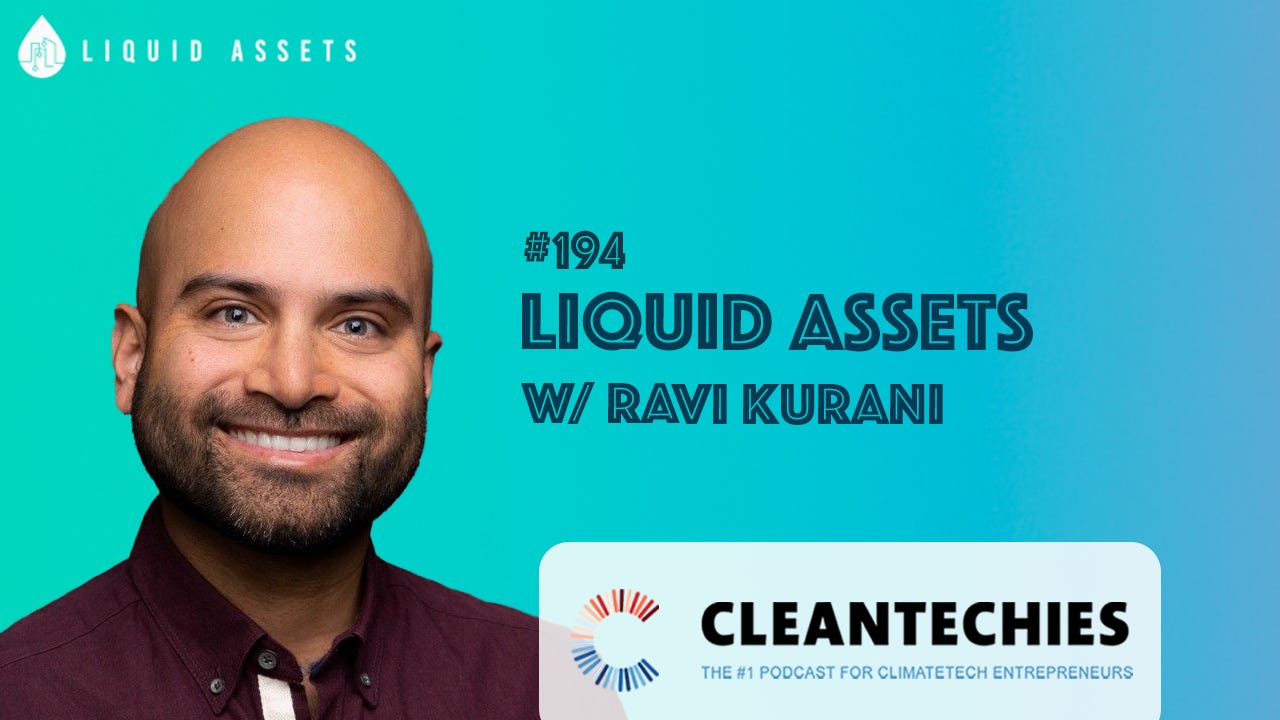Water you waiting for? Dive into the latest in H2Oh-mazing technology!
🌎 Welcome back to CleanTechies
We are The #1 Podcast For ClimateTech Entrepreneurs.
Convo’s (x2) with top climate entrepreneurs each week 🎙️
In-depth insights to distill the core lessons 🙋
Companies to watch lists weekly(ish) 📝
Monthly show with Somil & Silas 🤓
ClimateTech Investor? Entrepreneur? Maybe an aspiring one? Service provider?
If what you do touches early-stage ClimateTech, this is the place for you. 🤝
Too busy to listen? Check out the transcript below 👇 (if you’re reading in email, check out the full transcript by reading on Substack)
Today, we interview Ravi Kurani, Creator & Host of the Liquid Assets Podcast and CEO & Founder of Sutro
In the last episode, we learned how One Pont Five (OPF.Degree) is training 100k sustainability professionals.
Today Ravi Kurani teaches us what he’s learned from interviewing some of the leading voices in the water tech space.
You see, we had a lot of people asking for more about the water tech space — turns out we recently met someone who interviews all of those experts. We thought we’d get a 1 for X deal by speaking with Ravi.
But first, a little background on Ravi.
His Background: Growing up, he worked for his Dad who owned a chain of pool and spa supply stores. In his own words, he was basically a pool boy. After a short stint at NASA (🤯) he ended up working in a VC fund in India. There he was first exposed to the idea of impact investing.
Having had a taste for what it took to build a startup, he decided to try his hand at the entrepreneurship game and founded Sutro, a pool sensor company.
Fun fact #1: he actually ended up getting to know Sam Parr from My First Million well because they worked out of the same office in SF around this time.
Fun fact #2: Sam is one of my favorite entreprenuers and MFM is one of my favorite podcasts.
Through building Sutro, he got to know the ImagineH20 accelerator, where he met past guest Tom Ferguson (#178) (that’s how we found each other).
Not too long into his journey with Sutro, he sold to Sani Marc, and he is currently scaling up the technology.
📺 Watch on YouTube | 🍎 Apple Podcasts | 🎧 Spotify
Seeking a community of serious climate entrepreneurs? — Become a paid subscriber today to join our Slack community.
You’ll get (1) high-quality bonus content, (2) special speaker events, (3) ability to ask questions, (4) access to all our paid content, (5) and most importantly a great group of fellow Climate Builders.
Fast-forward: He now runs a podcast called Liquid Assets. Because he speaks with top water entrepreneurs, policy makers, and thought leaders, he has a wealth of knowledge.
That’s why today’s conversation is so good.
A few of the core topics that come to mind are:
The different categories of WaterTech
How the market being fragmented presents unique challenges to building in this space
The major differences between water and energy
How you should GTM in water
And perhaps most fascinating, why he thinks that water needs a new financing vehicle
This was a really fun episode, likely in part because he’s a fellow podcaster and in part because he just really knows his stuff.
If you haven’t already, check out Ravi’s pod by going to LiquidAssets.cc—give him a follow. It’s highly worth it.
Enjoy the episode! 🎧
Got future guest suggestions or topics? Leave a comment!
Unable to support financially but still want to help? Share this post w/ 3 ClimateTech (or aspiring) entrepreneurs. Sharing is super helpful to us, and it costs you nothing.
📝 Show Notes:
Topics
02:28 Intro
04:10 Learnings from Liquid Assets Podcast
08:09 The Categories of Water
11:20 Where Innovation Is
13:27 Energy x Water (Policy)
16:26 Upgrade to Paid Ad
18:01 GTM in Water
21:55 Power Dynamics and Wastewater
24:04 Telecom Parallel
24:52 Circularity x Water x Infrastructure
26:33 Owning Wastewater
28:45 Geo-Specific Challenges
31:04 Water Isn't Priced Right
32:20 KPIs for Success in Water
34:13 Global Water Hubs
35:35 Why Water is Close Knit
36:49 Startup Ideas
37:59 Water Needs New Financing Arm
Links
Connect with Ravi Kurani | Follow Liquid Assets
Connect with Somil on LinkedIn | Connect with Silas on LinkedIn
This podcast is NOT investment advice. Do your homework and due diligence before investing in anything discussed on this podcast.
Text Transcript 👇🏽
Silas Mähner:
Welcome to the show, Ravi. How are you doing today?
Ravi Kurani:
I am doing good, guys. How are you?
Silas Mähner:
We’re doing great! It's not often I get the chance to meet our guests in person, so I'm really excited about this one. Before we dive in, can you give us a brief introduction about yourself and what you do?
Ravi Kurani:
Absolutely. My name is Ravi Kurani. I'm the founder and president of Sutro, a water diagnostics company. We make a colorimetric sensor that floats in swimming pools and measures the water chemistry, providing real-time data on what adjustments need to be made. Besides running Sutro, I also host a podcast called Liquid Assets, where we explore the world of water through the lenses of technology, business, and policy.
Silas Mähner:
That’s fantastic! I’ve listened to some episodes of Liquid Assets, and you’ve had some really interesting guests. What inspired you to start this podcast?
Ravi Kurani:
It’s a bit of a journey. As the founder of a water company, I realized how vast and diverse the water industry is. Despite being a CEO in this space, I found there were many aspects of the industry I wasn’t fully aware of. So, I started Liquid Assets as a way to learn more about the industry while educating others. The podcast helps shine a light on the importance of water and the various innovations happening within the sector.
Silas Mähner:
Through your podcast, what are some of the key learnings or surprises you’ve encountered about the water industry?
Ravi Kurani:
One of the biggest things I’ve learned is how slow-moving the water industry is. Water is essential to everything we do, from drinking water to agriculture, which makes it highly regulated and resistant to change. This leads to long sales cycles and a cautious approach to new technologies. Another surprising aspect is how overlooked the industry is, despite its importance. Most investment goes into more visible sectors like SaaS or AI, rather than water. Finally, there’s a lot of innovation happening, but it often doesn’t get the spotlight it deserves due to the industry’s fragmented nature and the challenges of scaling up new technologies.
Somil Aggarwal:
Water is a critical yet often ignored area, especially when compared to other climate tech investments. How did you initially get into the water industry?
Ravi Kurani:
Interestingly, my entry into the water industry started when I was a kid. My dad owned a chain of pool and spa supply stores, so I grew up learning about water chemistry and testing pool water. After pursuing engineering and an MBA, I worked at an impact investing fund in India, where I saw firsthand the major issues surrounding water access and quality. These experiences combined to give me a unique perspective on the water industry.
Somil Aggarwal:
For those of us who aren’t as familiar, can you break down the water industry and its main segments?
Ravi Kurani:
The water industry can broadly be categorized into consumer water and industrial water. Consumer water includes everything we interact with daily, like drinking water, swimming pools, showers, and dishwashers. Industrial water is used in agriculture, manufacturing, and the built environment. Agriculture is the largest user of water, followed by industries like oil and gas, and then cooling towers in buildings. Understanding these categories helps in identifying where innovation can have the most impact, particularly in the industrial sector where water use is highest.
Silas Mähner:
Given your experience with both the consumer and industrial sides, where do you see the most significant innovations happening?
Ravi Kurani:
Innovations are happening across both consumer and industrial water segments. For instance, there are smart shower systems that help hotels and motels manage their water use more efficiently, and drone-based systems that monitor agricultural crops to optimize water and fertilizer use. Companies like Rainstick are working on gray and black water remediation, which is crucial for recycling water in various applications. Despite these innovations, the challenge remains in getting these technologies adopted widely due to the industry's slow sales cycles and regulatory hurdles.
Somil Aggarwal:
Water and energy are closely linked. Can you explain the energy-water nexus and its implications?
Ravi Kurani:
Absolutely. Moving and treating water requires a significant amount of energy. This connection means that reducing water consumption can also lead to energy savings. For example, using less water for irrigation or in industrial processes reduces the energy needed to pump and treat that water. Therefore, innovations that improve water efficiency can have a dual benefit of saving both water and energy.
Silas Mähner:
Policy plays a big role in the water industry. What are some policy challenges and how can they be addressed?
Ravi Kurani:
Water policies are often outdated and fragmented, which complicates effective water management. For example, California still uses water laws from the 1800s. Modernizing these policies is essential to better manage water resources and support new technologies. Additionally, there’s a need for policies that incentivize efficient water use and infrastructure upgrades to handle water recycling and reuse more effectively.
Somil Aggarwal:
You’ve mentioned gray and black water remediation as important areas for innovation. Can you elaborate on what these terms mean and their significance?
Ravi Kurani:
Gray water is relatively clean wastewater from baths, sinks, washing machines, and other kitchen appliances. Black water is more contaminated wastewater from toilets. Remediating and recycling these types of water can significantly reduce fresh water consumption. For example, using treated gray water for irrigation or flushing toilets can conserve a substantial amount of potable water. This kind of water recycling is crucial for sustainable water management, especially in areas facing water scarcity.
Silas Mähner:
It sounds like there are many exciting developments in water tech. For those interested in the field, where should they start looking for opportunities?
Ravi Kurani:
There are hubs for water tech innovation, particularly in areas with significant water issues like California. Organizations like Imagine H2O are great resources, as they connect startups with policy makers, corporates, and other stakeholders. Additionally, anywhere there is a critical water issue is a potential hub for innovation. For example, South Africa during its Day Zero crisis or Mexico City, which faces ongoing water scarcity challenges, are key areas where innovative solutions are needed.

















#194 Distilling the Water Industry, Water Policy, Cracking Distribution, Hybrid Financing, & More w/ Ravi Kurani (Liquid Assets Podcast)